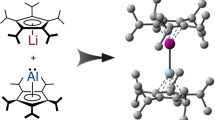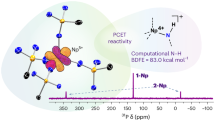Abstract
The structure and bonding of radium (Ra) is poorly understood because of challenges arising from its scarcity and radioactivity. Here we report the synthesis of a molecular Ra2+ complex using 226Ra and the organic ligand dibenzo-30-crown-10, and its characterization in the solid state by single-crystal X-ray diffraction. The crystal structure of the Ra2+ complex shows an 11-coordinate arrangement comprising the 10 donor O atoms of dibenzo-30-crown-10 and that of a bound water molecule. Under identical crystallization conditions, barium (Ba2+) yielded a 10-coordinate ‘Pac-Man’-shaped structure lacking water. Furthermore, the bond distance between the Ra centre and the O atom of the coordinated water is substantially longer than would be predicted from the ionic radius of Ra2+ and by analogy with Ba2+, supporting greater water lability in Ra2+ complexes than in their Ba2+ counterparts. Barium often serves as a non-radioactive surrogate for radium, but our findings show that Ra2+ chemistry cannot always be predicted using Ba2+.

This is a preview of subscription content, access via your institution
Access options
Access Nature and 54 other Nature Portfolio journals
Get Nature+, our best-value online-access subscription
$29.99 / 30 days
cancel any time
Subscribe to this journal
Receive 12 print issues and online access
$259.00 per year
only $21.58 per issue
Buy this article
- Purchase on Springer Link
- Instant access to full article PDF
Prices may be subject to local taxes which are calculated during checkout



Similar content being viewed by others
Data availability
CCDC depositions 2244265 and 2244266 contain the supplementary crystallographic data for this paper. The crystallographic data for Sm1, Ba2 and Ba3 are also located in the CCDC under depositions 1843893, reference code KEFFIK and reference code PANDUD. These data can be obtained free of charge via www.ccdc.cam.ac.uk/data_request/cif, by emailing data_request@ccdc.cam.ac.uk or by contacting The Cambridge Crystallographic Data Centre, 12 Union Road, Cambridge CB2 1EZ, UK; fax: +44 1223 336033. All data gathered in this manuscript are publicly available through the deposition CIF files.
References
McDevitt, M. R. et al. Tumor therapy with targeted atomic nanogenerators. Science 294, 1537–1540 (2001).
Kratochwil, C. et al. 225Ac-PSMA-617 for PSMA-targeted α-radiation therapy of metastatic castration-resistant prostate cancer. J. Nucl. Med. 57, 1941–1944 (2016).
Makvandi, M. et al. Alpha-emitters and targeted alpha therapy in oncology: from basic science to clinical investigations. Target. Oncol. 13, 189–203 (2018).
Thiele, N. A. & Wilson, J. J. Actinium-225 for targeted α therapy: coordination chemistry and current chelation approaches. Cancer Biother. Radiopharm. 33, 336–348 (2018).
Eychenne, R., Chérel, M., Haddad, F., Guérard, F. & Gestin, J. F. Overview of the most promising radionuclides for targeted alpha therapy: the ‘hopeful eight’. Pharmaceutics 13, 906 (2021).
Hu, A. & Wilson, J. J. Advancing chelation strategies for large metal ions for nuclear medicine applications. Acc. Chem. Res. 55, 904–915 (2022).
Kluetz, P. G. et al. Radium (Ra-223) dichloride injection: U.S. food and drug administration drug approval summary. Clin. Cancer Res. 20, 9–14 (2014).
Parker, C. et al. Alpha emitter radium-223 and survival in metastatic prostate cancer. N. Engl. J. Med. 369, 213–223 (2013).
Sartor, O. et al. Effect of radium-223 dichloride on symptomatic skeletal events in patients with castration-resistant prostate cancer and bone metastases: results from a phase 3, double-blind, randomised trial. Lancet Oncol. 15, 738–746 (2014).
Henriksen, G. et al. Targeting of osseous sites with α-emitting 223Ra: comparison with the α-emitter 89Sr in mice. J. Nucl. Med. 44, 252–259 (2003).
Takalkar, A., Adams, S. & Subbiah, V. Radium-223 dichloride bone-targeted alpha particle therapy for hormone-refractory breast cancer metastatic to bone. Exp. Hematol. Oncol. 3, 1–7 (2014).
Marques, I. A. et al. Targeted alpha therapy using radium-223: from physics to biological effects. Cancer Treat. Rev. 68, 47–54 (2018).
Chen, X., Ji, M., Fisher, D. R. & Wai, C. M. Ionizable calixarene-crown ethers with high selectivity for radium over light alkaline earth metal ions. Inorg. Chem. 38, 5449–5452 (1999).
Henriksen, G., Hoff, P. & Larsen, R. H. Evaluation of potential chelating agents for radium. Appl. Radiat. Isot. 56, 667–671 (2002).
Gott, M., Steinbach, J. & Mamat, C. The radiochemical and radiopharmaceutical applications of radium. Open Chem. 14, 118–129 (2016).
Freesmeyer, M., Weigand, W. & Weisheit, T. Examination of the complexation ability of different calixarene derivatives towards [223Ra]RaCl2 in a hospital radiopharmaceutical laboratory. Nuklearmedizin 57, 242–246 (2018).
Riondato, M., Pastorino, S., Duce, V., Giovannini, E. & Ciarmiello, A. Comparative radium-223 labeling with NOTA- and DOTA-somatostatin derivatives for a potential use in targeted cancer therapy. Nucl. Med. Biol. 72–73, S50–S51 (2019).
Abou, D. S. et al. Towards the stable chelation of radium for biomedical applications with an 18-membered macrocyclic ligand. Chem. Sci. 12, 3733–3742 (2021).
Ivanov, A. S. et al. Elucidating the coordination chemistry of the radium ion for targeted alpha therapy. Chem. Commun. 58, 9938–9941 (2022).
Shannon, R. D. Revised effective ionic radii and systematic studies of interatomic distances in halides and chalcogenides. Acta Crystallogr. A 32, 751–767 (1976).
Weigel, F. & Trinkl, A. Crystal chemistry of radium. I. Radium halides. Radiochim. Acta 9, 36–41 (1968).
Weigel, F. & Trinkle, A. Crystal chemistry of radium. II. Radium salts of the RaXO4 type (X = sulfur, selenium, chromium, molybdenum, tungsten). Radiochim. Acta 9, 140–144 (1968).
Weigel, F. & Trinkl, A. Crystal chemistry of radium. III. Preparation, crystal structure, and atomic radius of metallic radium. Radiochim. Acta 10, 78–82 (1968).
Weigel, F. & Trinkl, A. Crystal chemistry of radium. IV. Radium sulfide and selenide. Radiochim. Acta 12, 29–31 (1969).
Weigel, F. & Trinkl, A. On the crystal chemistry of radium V. Various radium salts of inorganic anions. Radiochim. Acta 19, 199–202 (1973).
Matyskin, A. V., Ylmen, R., Lagerkvist, P., Ramebäck, H. & Ekberg, C. Crystal structure of radium sulfate: an X-ray powder diffraction and density functional theory study. J. Solid State Chem. 253, 15–20 (2017).
Stanjek, H. & Häusler, W. Basics of X-ray diffraction. Hyperfine Interact 154, 107–119 (2004).
Thiele, N. A. et al. An eighteen‐membered macrocyclic ligand for actinium‐225 targeted alpha therapy. Angew. Chem. Int. Ed. 129, 14904–14909 (2017).
Price, E. W. & Orvig, C. Matching chelators to radiometals for radiopharmaceuticals. Chem. Soc. Rev. 43, 260–290 (2014).
Okoye, N. C., Baumeister, J. E., Khosroshahi, F. N., Hennkens, H. M. & Jurisson, S. S. Chelators and metal complex stability for radiopharmaceutical applications. Radiochim. Acta 107, 1087–1120 (2019).
Yang, H. et al. Harnessing alpha-emitting radionuclides for therapy: radiolabeling method review. J. Nucl. Med. 63, 5–13 (2021).
Yamaguchi, A. et al. Extended X-ray absorption fine structure spectroscopy measurements and ab initio molecular dynamics simulations reveal the hydration structure of the radium(II) ion. iScience 25, 104763 (2022).
Bai, Z. et al. Radium revisited: revitalization of the coordination chemistry of nature’s largest +2 cation. Inorg. Chem. 62, 8478–8481 (2023).
Bush, M. A. & Truter, M. R. Crystal structures of complexes between alkali-metal salts and cyclic polyethers. Part IV. The crystal structures of dibenzo-30-crown-10 (2,3:17,18-dibenzo-1,4,7,10,13,16,19,22,25,28-decaoxacyclotriaconta-2,17-diene) and of its complex with potassium iodide. J. Chem. Soc. Perkin Trans. 2, 345–350 (1972).
Owen, J. D., Truter, M. R. & Wingfield, J. N. Reaction between dibenzo-30-crown-10 and potassium thiocyanate; structures of the 1:1 complexes, anhydrous and monohydrated, [K(C28H40O10)]+[SCN]− and [K(C28H40O10)]+[SCN]−∙H2O. Acta Crystallogr. C 40, 1515–1520 (1984).
Li, Z., Xu, H., Wang, X. & Fan, Y. Crystal and molecular structure of dibenzo-30-crown-10-barium complex with bismuth trichloride. Jiegou 8, 273–277 (1989).
Fan, Y., Xu, H., Wei, Y. & Hu, Q. Crystal and molecular structure of [Ba(DB30C10)(H2O)]2[Co(NCS4)]2H2O. Shandong Daxue Xuebao, Ziran Kexueban 26, 129–138 (1991).
White, F. D. et al. Molecular and electronic structure, and hydrolytic reactivity of a samarium(II) crown ether complex. Inorg. Chem. 58, 3457–3465 (2019).
Cowie, B. E., Douair, I., Maron, L., Love, J. B. & Arnold, P. L. Selective oxo ligand functionalisation and substitution reactivity in an oxo/catecholate-bridged UIV/UIV Pacman complex. Chem. Sci. 11, 7144–7157 (2020).
Pettit, W. A. & Baenziger, N. C. Barium (cryptand-222B)Cl2∙6H2O. Acta Crystallogr. C 50, 221–224 (1994).
Rodriguez-Cruz, S. E., Jockusch, R. A. & Williams, E. R. Hydration energies and structures of alkaline earth metal ions, M2+(H2O)(n), n = 5–7, M = Mg, Ca, Sr, and Ba. J. Am. Chem. Soc. 121, 8898–8906 (1999).
Chekhlov, A. N. Crystal structure of the diaqua(1,10-diaza-18-crown-6)(tetrafluorosuccinato-O)barium complex. Russ. J. Coord. 28, 137–142 (2002).
Chekhlov, A. N. Crystal structure of an unusual hydrated complex of 1,4,7,10,13-pentaoxacyclohexadecane-14,16-dione with calcium thiocyanate. Russ. J. Coord. 28, 163–169 (2002).
Chekhlov, A. N. Twinned and disordered crystal structure of solvated bis[bqua(2.2.2-cryptand)calcium] hexa(isothiocyanato)calciate. Russ. J. Coord. 28, 454–460 (2002).
Chekhlov, A. N. Crystal structure of diaqua(2.2.2-cryptand)strontium bis(thiocyanate). J. Struct. Chem. 43, 501–506 (2002).
Simms, M. E. et al. Reining in radium for nuclear medicine: extra-large chelator development for an extra-large ion. Inorg. Chem. https://doi.org/10.1021/acs.inorgchem.3c02985 (2023).
Sheldrick, G. M. Crystal structure refinement with SHELXL. Acta Crystallogr. C 71, 3–8 (2015).
Dolomanov, O. V., Bourhis, L. J., Gildea, R. J., Howard, J. A. K. & Puschmann, H. OLEX2: a complete structure solution, refinement and analysis program. J. Appl. Crystallogr. 42, 339–341 (2009).
Cary, S. K., Boland, K. S., Cross, J. N., Kozimor, S. A. & Scott, B. L. Advances in containment methods and plutonium recovery strategies that led to the structural characterization of plutonium(IV) tetrachloride tris-diphenylsulfoxide, PuCl4(OSPh2)3. Polyhedron 126, 220–226 (2017).
Acknowledgements
The staff of the Medical Isotopes Development Group and the Building 3047 Operations Group at Oak Ridge National Laboratory are thanked for their 226Ra production, purification and dispensing efforts. This research was supported by the Laboratory Directed Research and Development (N.A.T.) programme of Oak Ridge National Laboratory. The 226Ra used in this research was supplied by the United States Department of Energy Isotope Program, managed by the Office of Isotope R&D and Production. The manuscript was produced by UT–Battelle, LLC under contract no. DE-AC05-00OR22725 with the United States Department of Energy. The publisher acknowledges the United States Government licence to provide public access under the Department of Energy (DOE) Public Access Plan (https://energy.gov/downloads/doe-public-access-plan). The funders had no role in the study design, data collection and analysis, decision to publish or preparation of the manuscript.
Author information
Authors and Affiliations
Contributions
F.D.W. constructed and executed the preparation, synthesis, imaging and characterization of Ra/Ba complexes. N.A.T. developed the concept of Ra scXRD and acquired and prepared the stock solution of 226Ra. S.K.C. aided in crystal manipulations for scXRD and 226Ra imaging experiments. M.E.S. aided in preparing the radiological hood for 226Ra work, prepping the 226Ra stock solution and setting up the 226Ra reaction.
Corresponding authors
Ethics declarations
Competing interests
The authors declare no competing interests.
Peer review
Peer review information
Nature Chemistry thanks Rebecca Abergel, Caterina Ramogida and the other, anonymous, reviewer(s) for their contribution to the peer review of this work.
Additional information
Publisher’s note Springer Nature remains neutral with regard to jurisdictional claims in published maps and institutional affiliations.
Supplementary information
Supplementary Information
Supplementary Figs. 1 and 2, Tables 1 and 2 and discussion of CIF B-alerts.
Supplementary Data 1
ScXRD structure of Ba1.
Supplementary Data 2
ScXRD structure of Ra1.
Rights and permissions
Springer Nature or its licensor (e.g. a society or other partner) holds exclusive rights to this article under a publishing agreement with the author(s) or other rightsholder(s); author self-archiving of the accepted manuscript version of this article is solely governed by the terms of such publishing agreement and applicable law.
About this article
Cite this article
White, F.D., Thiele, N.A., Simms, M.E. et al. Structure and bonding of a radium coordination compound in the solid state. Nat. Chem. 16, 168–172 (2024). https://doi.org/10.1038/s41557-023-01366-z
Received:
Accepted:
Published:
Issue Date:
DOI: https://doi.org/10.1038/s41557-023-01366-z
This article is cited by
-
Doing away with radium’s proxies
Nature Chemistry (2024)



